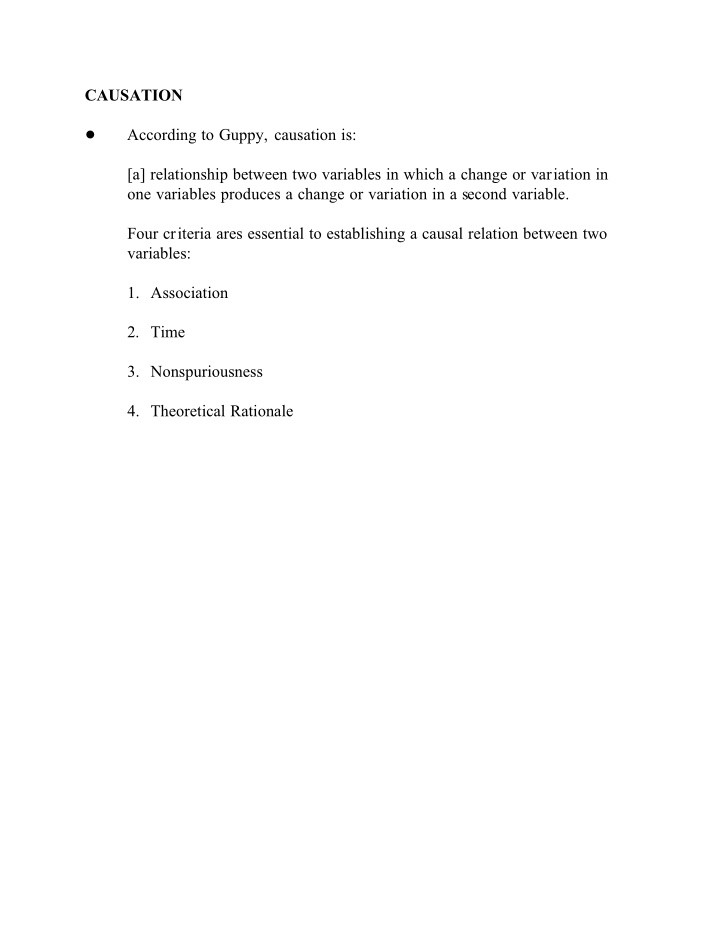



CAUSATION According to Guppy, causation is: � [a] relationship between two variables in which a change or variation in one variables produces a change or variation in a second variable. Four criteria ares essential to establishing a causal relation between two variables: 1. Association 2. Time 3. Nonspuriousness 4. Theoretical Rationale
Independent and Dependent Variables An independent variable is the cause of a dependent variable . � A dependent variable is the effect of an independent variable . � To reiterate, the independent variable is the cause and the dependent � variable is the effect. The dependent variable is what you are interested in explaining. � It is dependent upon the independent variable in that its value changes (at � least in part) as a function of changes in the independent variable. For instance, if you hypothesize that: � H1: Income is positively associated with level of formal education. Level of formal education is the independent variable and income is the dependent variable . The above might be restated as follows: The greater the number of years of formal education one has, the higher their annual income. It should be noted that any given variable might be treated as independent � in one part of the analysis and dependent in another part of the analysis.
For Example, for Marx: Economic Religious & Structures -----> Ideological Structures For Weber: Religious & Ideological -----> Economic Structures Structures For Marx the economy is an independent variable, and religion a dependent variable. For Weber religion is an independent variable, and the economy an independent variable. Weber clarified such relationships further by stating that it is perfectly legitimate to explore a given variable as an independent variable in one analysis, and a dependent variable in another. In so doing with regard to the connection between religion and the economy, he was said to be rounding out the work of Marx. I would note, that such relationships have to make "causal sense". � For example age might affect level of psychological development, but level of psychological development can not affect age.
Necessary and Sufficient Causes With probabilistic model of the sort we usually consider within sociology, � it is useful to distinguish between two types of causes: necessary causes and sufficient causes. A necessary cause represents a condition that must be present for the � effect to follow. For example, it is necessary for a person to be a women to become pregnant, even though not all women do become pregnant. A sufficient cause represents a condition which, if it is present, inevitably � results in the effect. Enlisting in the army is a sufficient cause for being issued a uniform, even though there are other ways of acquiring uniforms. For any given phenomenon we seek to explain, we ideally hope to discover � a cause that is both necessary and sufficient. Unfortunately, we rarely discover causes that are both necessary and sufficient. In fact, as Guppy notes, multiple causes are the rule in most social scientific explanation.
THIRD VARIABLES AND CAUSAL RELATIONS Explanations which are confined to only two variables tend to be overly � simplistic. Sociologists must almost always consider one or more additional third � variables. How a third variable is incorporated into an analysis depends on how the � hypothesis relates it to the independent variable. Intervening Variables: An intervening variable is one that occurs in time between the occurrence � of the independent variable and the occurrence of the dependent variable. Antecedent Variables: An antecedent variable is one that occurs earlier in time than either the � independent or the dependent variable. ** SEE EDUCATION --> OCCUPATIONAL STATUS EXAMPLE
Spurious Relationships: A spurious relationship is an originally observed association between two variables � that disappears when a third variable is introduced into the analysis. In such cases the third variable must be antecedent to the first two, and cause them. For example: storks and births (urban vs. rural settings) � � tigers and crimes (city size) religious attendance and shoe size (gender) � number of fire trucks and amount of damage caused by a fire �
CONTROLLING FOR THIRD VARIABLES In developing explanations that attempt to incorporate multiple causal factors, we may � start off by examining the relationship between two variables (ideally an independent and dependent variable), but then we try to "control" (or hold constant) important third variables (antecedent or intervening). For example, lets say we are interested in gender inequality, or more precisely, the � relationship between gender and income. According to available statistics, if we look at all men and women in the paid labour force in 1982, women earned about 50% of what men earned. If we control by full-time vs part-time employment, and look only at those employed full-time then women earned about 64% of what their male counterparts earned. If we control for amount of formal education, this differences decreases again. In this case, we can also control for other important variables such as ethnicity/race, type of job, years of experience, etc. While research as show that there still tend to be a gap between the earnings of men and women that indicates discrimination against women, this gap is exaggerated if we only make gross comparisons -- e.g., between all men and all women in the paid labour force.
Recommend
More recommend